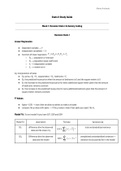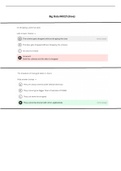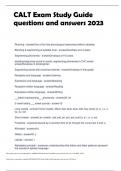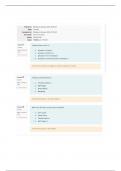Lecture notes
Lecture 1
Social brain theory: human beings have larger brains due to complex social behaviour
3 themes:
Humans don’t know everything -> ‘cognitive misers’ (limited mental capacity)
Humans are efficient and well-organised info processors
Cognitions and affect are intrinsically connected
Tversky & Kahneman: our mental toolbox
Heuristics:
- Representativeness heuristic: how much does it look like what you know?
- Availability heuristic: how available is the info in your memory?
- Anchoring: what is your point of reference?
Schemas: Mental framework that organises social info and guides our perceptions
and actions
Automaticity: controlled vs. automatic thinking
Negativity bias and hope for good:
- Bad is stronger than good
- Optimistic bias: tendency to overlook risks and expect positive outcomes
- Planning fallacy: tendency to think that tasks take up less time than they actually
do
Regret: action vs. inaction
Affect and cognition: we are more likely to remember or store positive info in
positive mood (same for negative). Perception based on our feelings (it feels bad -> it
is bad)
Priming and perseverance effect: activated schemas persist even in the face of inconsistent
knowledge
Lecture 2: Social perception
Social perception = how we perceive others
Facial feedback theory: muscles strengthening our feelings
Basic channels
Facial expressions: six basic/universal emotions (anger, fear, disgust, surprise,
sadness and happiness).
Gazes and stares: advanced gaze detection system in vision cortex
Body language
Touch
Smiling:
Lower punishment
Higher tips
More likely to get a job
,Attributions
Correspondence bias (fundamental attribution error): contribute behaviour to
internal causes. Causes: salience person vs. situation, limited perspective on situation
and cognitive capacity
Actor/observer bias: matter of choice
Self-serving bias: attribute success internally and failure externally
Theory Kelley: consensus (among people), consistency (similar situations) and
distinctiveness (different situations)
Impression formation and management
How do we integrate info to form a first impression?
Evaluations often made quickly with little info: goodness/badness of person, like or
dislike person, central traits (traits highly associated with other characteristics
Implicit personality theory: person kind? Other traits also positive
Two conditions: warm and cold conditions
Negativity effect: we pay more attention to negative traits of person when forming
impressions, but positive bias -> we are more likely to express positive evaluations of
people, than negative
Self-handicapping vs. sucking up
Lecture 3
Theme 1
How well do you know yourself?
Intentions vs behaviour: self-other discrepancy
Self vs others: what is correct?
How to know yourself?
Introspection: conscious access. Problem: we don’t always have conscious access to
our motivations (why we do things)
Affective forecasting bias: overprojection of current feelings + failure to consider
context
Social comparison: judging ourselves in comparison to others (when we don’t know
how to see ourselves). With whom depends on your goals -> for accurate self-image:
similar others, self-enhancement: downward comparisons, what can we strive for?:
upward comparison
How do you define yourself?
A) Physical: female, age
B) Social: nationality, political preference
C) Psychological: shy, outgoing
D) Holistic: human being
Cultural differences:
Interdependent self-view: relationship to others -> non-western self-view
Independent self-view: internal thoughts -> western self-view
, Age differences:
Young people define more personality traits
Older people more social/collective
Gender differences:
Women: close relationships
Men: memberships in large groups
Social identity theory: self-perception mostly determined by context (depends on situation)
Centrality: also matters a lot -> sexual orientation and religion
Which part of your identity is salient?
Context
Comparison
Centrality
Feeling good about ourselves
Disapproval by others
Self-esteem
Cutting off reflected failure
Stereotype threat
Hard to cut off reflected failure when being part of that group
People perform worse: fear to confirm stereotype, bad performance, negative
stereotype
Theme 2
When is a group a group? 2 or more people who interact with each other and have a
common goal of fulfil a need together
Why join groups? Evolutionary explanations
Why work in groups? Task goals (knowledge/info) + social goals (need to belong)
Joining groups: initiation rites
Groups: key components
Status: hierarchy (physical characteristics, behaviour and seniority)
Roles: formal (agreed upon) and informal roles (behaviour)
Norms: group norms -> shared expectations about specific group members’
behaviours +
Cohesiveness: forces that cause members to stay in the group. Effects high
cohesiveness -> high participation rate in activities
Cooperation and conflict
Lecture 1
Social brain theory: human beings have larger brains due to complex social behaviour
3 themes:
Humans don’t know everything -> ‘cognitive misers’ (limited mental capacity)
Humans are efficient and well-organised info processors
Cognitions and affect are intrinsically connected
Tversky & Kahneman: our mental toolbox
Heuristics:
- Representativeness heuristic: how much does it look like what you know?
- Availability heuristic: how available is the info in your memory?
- Anchoring: what is your point of reference?
Schemas: Mental framework that organises social info and guides our perceptions
and actions
Automaticity: controlled vs. automatic thinking
Negativity bias and hope for good:
- Bad is stronger than good
- Optimistic bias: tendency to overlook risks and expect positive outcomes
- Planning fallacy: tendency to think that tasks take up less time than they actually
do
Regret: action vs. inaction
Affect and cognition: we are more likely to remember or store positive info in
positive mood (same for negative). Perception based on our feelings (it feels bad -> it
is bad)
Priming and perseverance effect: activated schemas persist even in the face of inconsistent
knowledge
Lecture 2: Social perception
Social perception = how we perceive others
Facial feedback theory: muscles strengthening our feelings
Basic channels
Facial expressions: six basic/universal emotions (anger, fear, disgust, surprise,
sadness and happiness).
Gazes and stares: advanced gaze detection system in vision cortex
Body language
Touch
Smiling:
Lower punishment
Higher tips
More likely to get a job
,Attributions
Correspondence bias (fundamental attribution error): contribute behaviour to
internal causes. Causes: salience person vs. situation, limited perspective on situation
and cognitive capacity
Actor/observer bias: matter of choice
Self-serving bias: attribute success internally and failure externally
Theory Kelley: consensus (among people), consistency (similar situations) and
distinctiveness (different situations)
Impression formation and management
How do we integrate info to form a first impression?
Evaluations often made quickly with little info: goodness/badness of person, like or
dislike person, central traits (traits highly associated with other characteristics
Implicit personality theory: person kind? Other traits also positive
Two conditions: warm and cold conditions
Negativity effect: we pay more attention to negative traits of person when forming
impressions, but positive bias -> we are more likely to express positive evaluations of
people, than negative
Self-handicapping vs. sucking up
Lecture 3
Theme 1
How well do you know yourself?
Intentions vs behaviour: self-other discrepancy
Self vs others: what is correct?
How to know yourself?
Introspection: conscious access. Problem: we don’t always have conscious access to
our motivations (why we do things)
Affective forecasting bias: overprojection of current feelings + failure to consider
context
Social comparison: judging ourselves in comparison to others (when we don’t know
how to see ourselves). With whom depends on your goals -> for accurate self-image:
similar others, self-enhancement: downward comparisons, what can we strive for?:
upward comparison
How do you define yourself?
A) Physical: female, age
B) Social: nationality, political preference
C) Psychological: shy, outgoing
D) Holistic: human being
Cultural differences:
Interdependent self-view: relationship to others -> non-western self-view
Independent self-view: internal thoughts -> western self-view
, Age differences:
Young people define more personality traits
Older people more social/collective
Gender differences:
Women: close relationships
Men: memberships in large groups
Social identity theory: self-perception mostly determined by context (depends on situation)
Centrality: also matters a lot -> sexual orientation and religion
Which part of your identity is salient?
Context
Comparison
Centrality
Feeling good about ourselves
Disapproval by others
Self-esteem
Cutting off reflected failure
Stereotype threat
Hard to cut off reflected failure when being part of that group
People perform worse: fear to confirm stereotype, bad performance, negative
stereotype
Theme 2
When is a group a group? 2 or more people who interact with each other and have a
common goal of fulfil a need together
Why join groups? Evolutionary explanations
Why work in groups? Task goals (knowledge/info) + social goals (need to belong)
Joining groups: initiation rites
Groups: key components
Status: hierarchy (physical characteristics, behaviour and seniority)
Roles: formal (agreed upon) and informal roles (behaviour)
Norms: group norms -> shared expectations about specific group members’
behaviours +
Cohesiveness: forces that cause members to stay in the group. Effects high
cohesiveness -> high participation rate in activities
Cooperation and conflict











